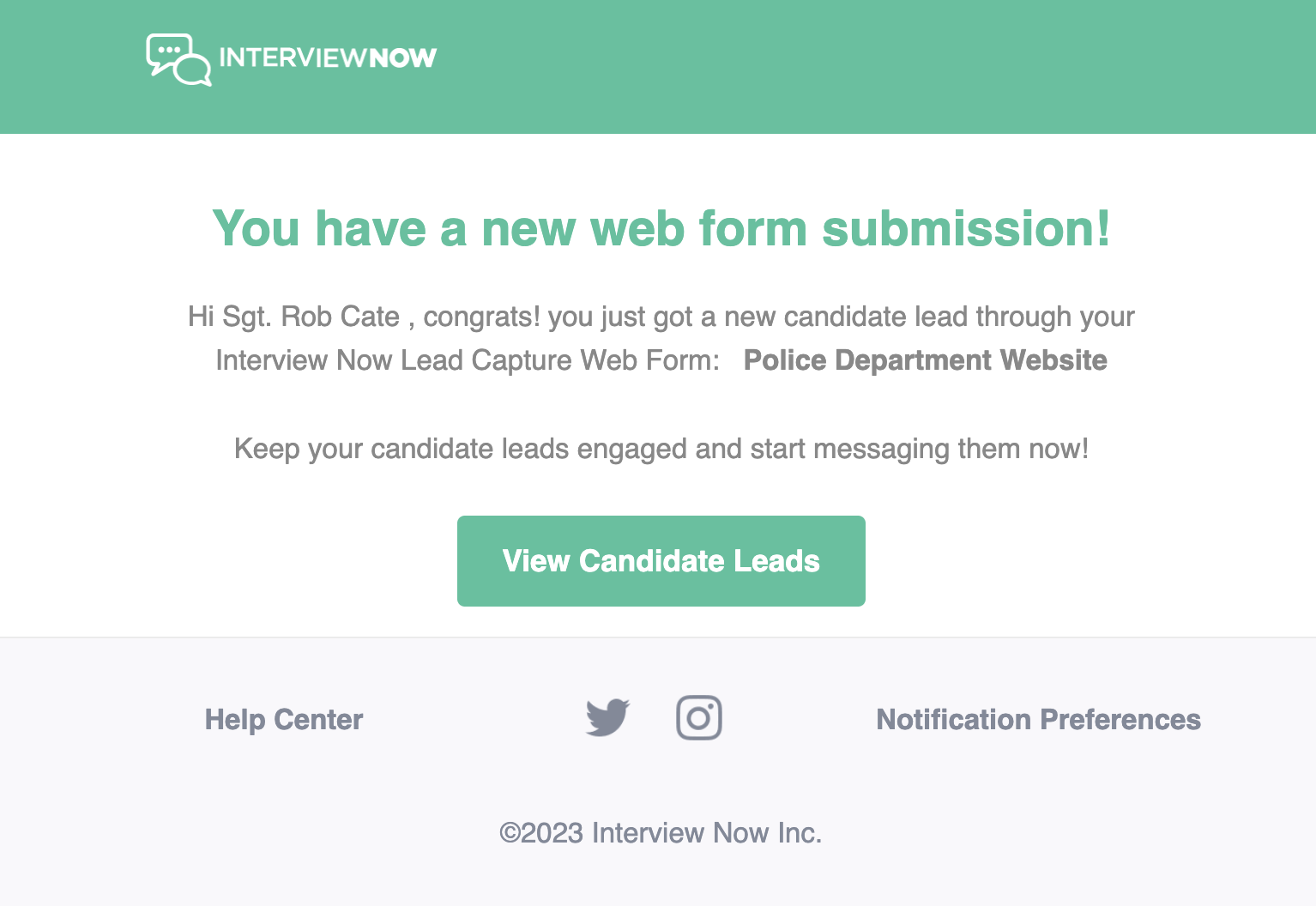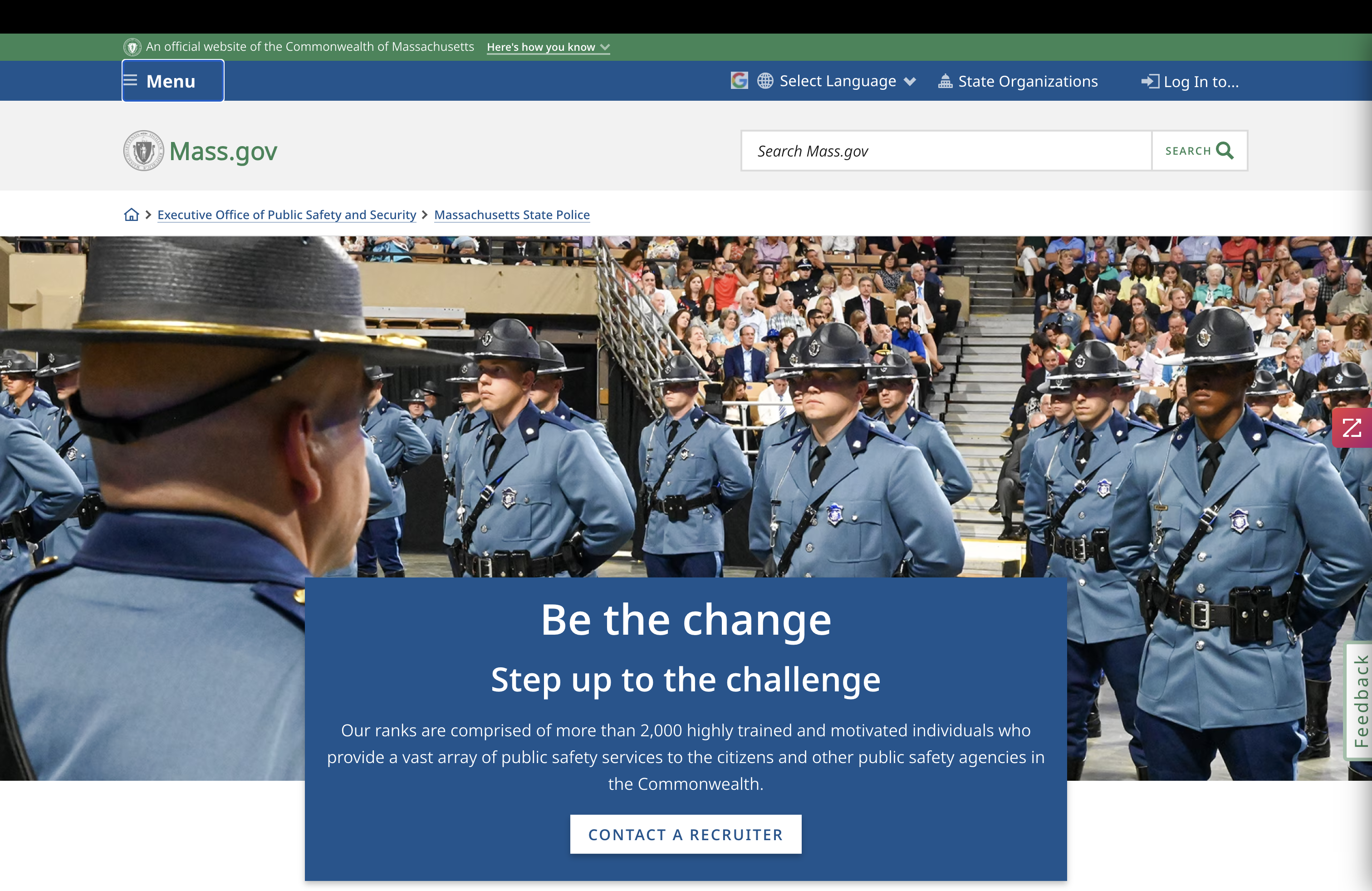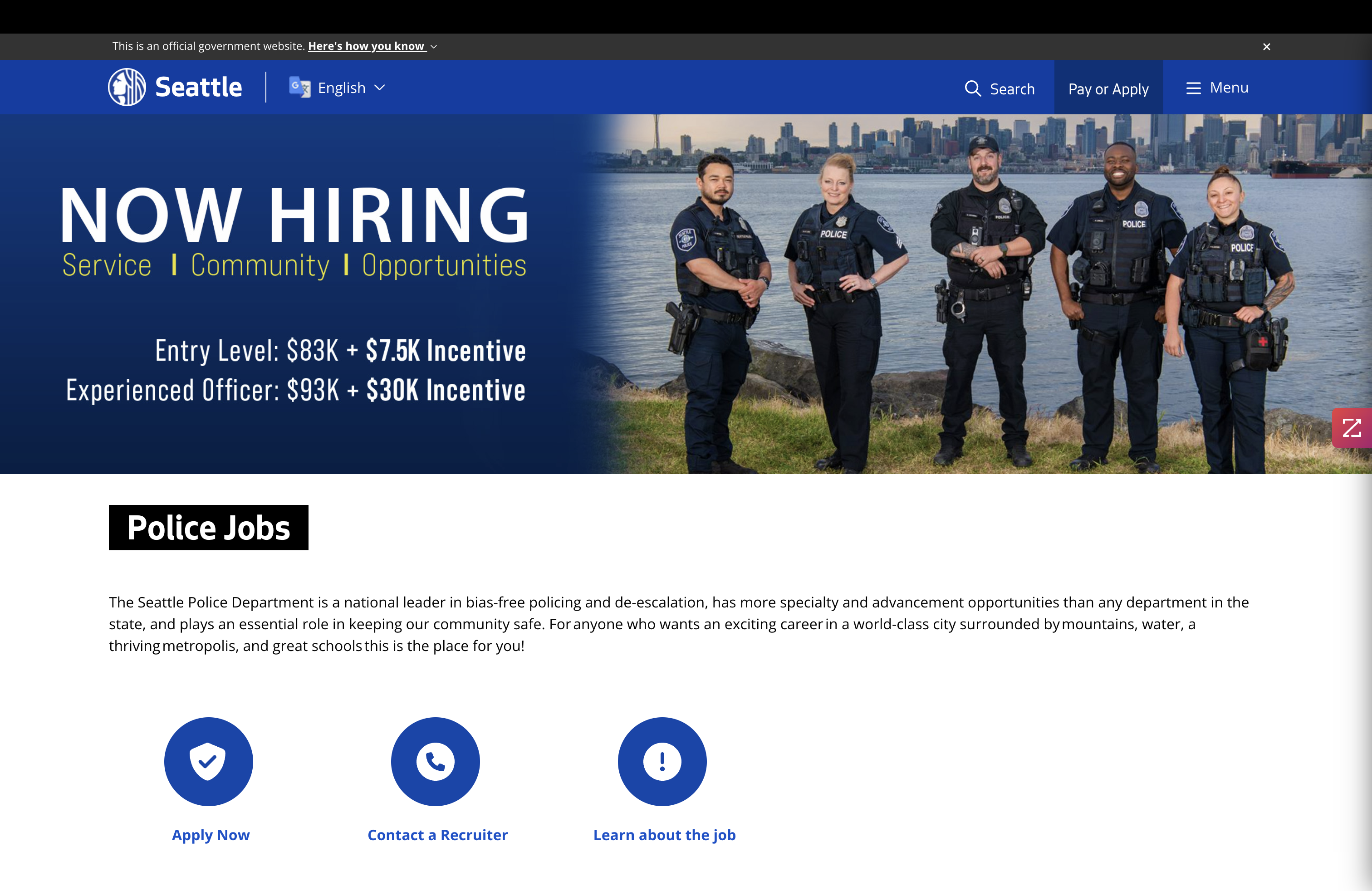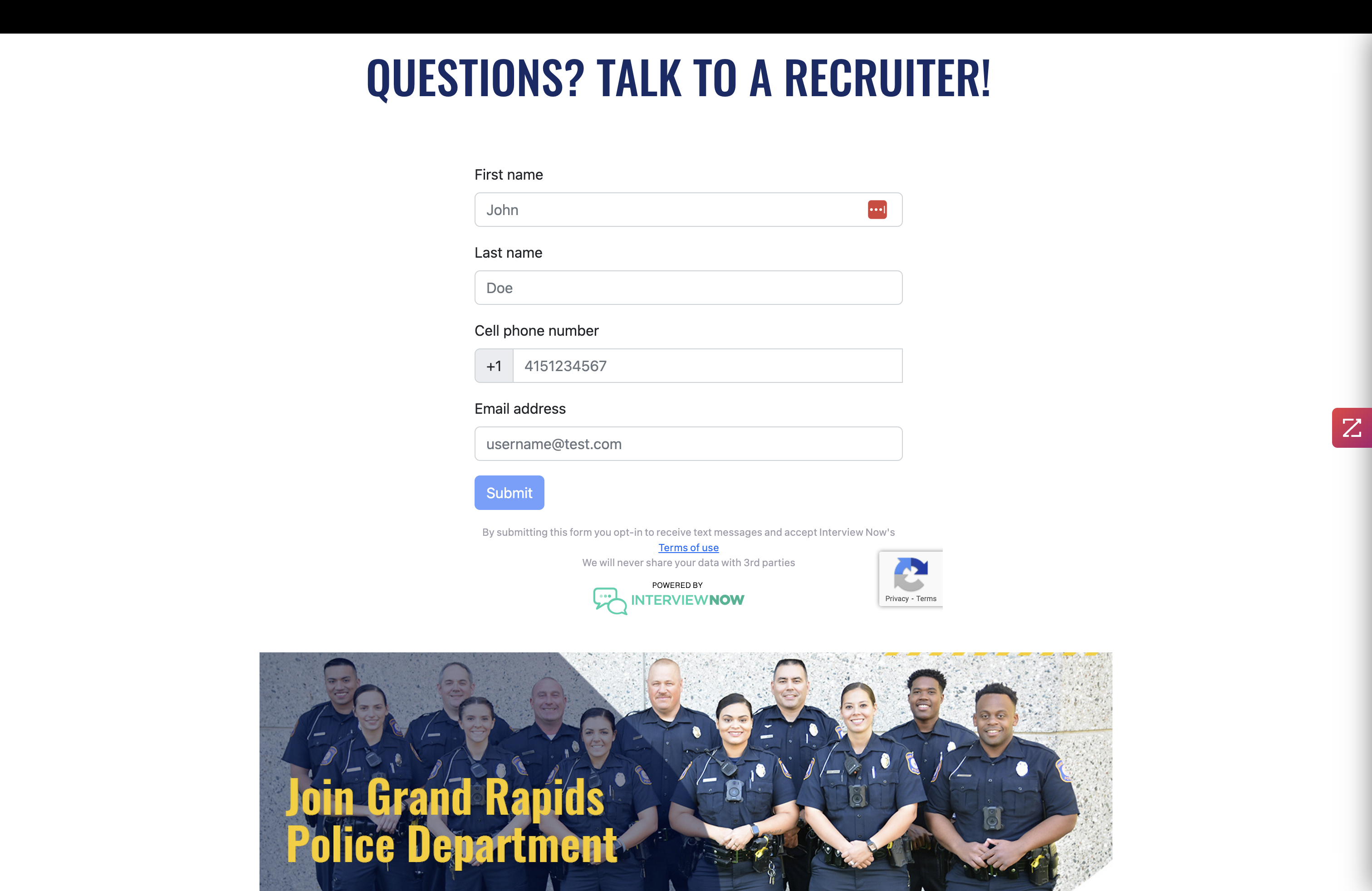
Maximizing Conversion in Law Enforcement Recruitment: How to Effectively Utilize Lead Capture Forms and CTAs
Introduction
Capturing the interest of potential recruits is a vital task in law enforcement, and in today’s digital age the process often begins online. Your website’s design plays a crucial role in this engagement, and, with Interview Now’s Lead Capture Forms, connecting with potential applicants has never been easier. These specially designed forms not only simplify the process of capturing candidate information and tracking referral sources, but also enable immediate connection through text messaging.

To fully benefit from lead capture forms, however, you need to ensure you are strategically placing them on your site and accompanying them with strong Calls to Action. CTAs guide potential recruits through the recruitment and hiring process and significantly impact lead conversion rates, making them an essential part of building the next generation of law enforcement professionals.
For law enforcement recruiters, understanding the science of web form optimization goes beyond mere aesthetics; it serves as a strategic tool in reaching, engaging, and converting promising candidates. In this post, we will explore the significant role that Lead Capture Forms and CTAs play in the recruitment process, delving into the advantages of strategic placement and uncovering common pitfalls that may hinder your efforts to connect with potential applicants. Alongside this, we will provide actionable insights and best practices, helping you optimize your recruitment strategies and ensuring you harness the full potential of Interview Now’s essential tools.
Section 1: Understanding Lead Capture Forms and Their Strategic Placement
Subsection 1.1: The Role of Lead Capture forms in Law Enforcement Recruitment
Interview Now Lead Capture forms are an essential part of the modern recruitment toolbox, offering versatility and potency in capturing and engaging candidates through text messaging. Whether embedded within a web page or shared as a standalone URL link, these forms enable immediate candidate engagement. Upon submission, recruiters receive an email notification, allowing them to initiate contact directly through the dashboard. The flexibility to create an unlimited number of forms, coupled with the ability to track referral sources for each submission, provides a robust toolset for recruiters. Furthermore, grouping candidate submissions and reaching out in bulk simplifies and streamlines the recruitment process, enhancing efficiency without compromising personal engagement.

Becoming a law enforcement officer in today’s complex environment is a decision filled with challenges. The current climate requires potential recruits to navigate personal and professional considerations, creating hesitations that can deter promising candidates. Simply put, candidates might not be ready to apply…and that’s okay!
Ease of access and engagement becomes vital in this context. By utilizing Lead Capture forms, law enforcement recruiters can significantly lower the barriers to entry. These forms enable immediate connection through text messaging, allowing recruiters to build rapport and trust from the very start, signaling to the candidate that their interest and time are valued.
In both law enforcement and collegiate athlete recruitment, building a personal connection is paramount. Leveraging text messaging in the recruitment process creates a direct and immediate line of communication, much like a coach reaching out to a prospective player.
Subsection 1.2: The Benefits of Strategic Form Placement
Strategic placement of Interview Now Lead Capture forms isn’t merely an aesthetic consideration; it’s a vital component of an effective law enforcement recruitment strategy. The placement of these forms can significantly influence the user experience, engagement, and ultimately, the conversion rate. Here’s why:
Visibility and Accessibility:
-
- Ease of Access: Lead Capture forms must be easily visible and accessible to potential recruits. Placing them prominently on relevant pages, such as career or recruitment sections, ensures that candidates don’t have to search extensively to express their interest.
- Enhanced User Experience: This ease of access can enhance user experience and encourage more submissions.
Contextual Relevance:
-
- Alignment with Content: The positioning of Lead Capture forms should align with the content and flow of the web page. For example, placing a form next to information about specific roles or departments within law enforcement can drive targeted engagement.
- Guiding Candidates: This contextual alignment helps in guiding the candidates through their exploration and nudging them towards action.
Avoiding Overcrowding:
-
- Clear Pathway: Too many elements competing for attention can create confusion and detract from the main call-to-action. Strategic placement of Lead Capture forms means avoiding overcrowding and ensuring that the form stands out as a clear pathway for potential recruits.
Mobile Optimization:
-
- Accessibility on Devices: With many candidates accessing recruitment information on mobile devices, Lead Capture forms must be strategically placed for optimal mobile viewing.
- Alignment and Sizing: Proper alignment and sizing ensure that the forms are as effective on mobile devices as they are on desktops.
Tracking and Analytics:
-
- Understanding Placement Impact: Interview Now’s ability to track referral sources of each submission allows recruiters to understand what placements work best.
- Data-Driven Optimization: This data-driven approach enables ongoing optimization, ensuring that forms are placed where they have the most impact.
Integration with Calls to Action (CTAs):
-
- Working with CTAs: Lead Capture forms often work in conjunction with CTAs to guide potential recruits.
- Seamless User Journey: Proper alignment between forms and accompanying CTAs creates a seamless user journey, enhancing the conversion rate.
Here are a few examples of effective placement of Lead Capture forms:

Why it’s effective: This Lead Capture form is a URL link placed directly under the fold for candidates to immediately see when visiting the site. There is a clear CTA to Contact a Recruiter.
–URL Style Lead Capture Form, Massachusetts State Police

Why it’s effective: This Lead Capture form is placed on a secondary Contact a Recruiter page with the URL link placed directly under the fold for candidates to immediately see when visiting the site. There is a clear CTA to Contact a Recruiter.
–URL Style Lead Capture Form, Seattle Police Department

Why it’s effective: This Lead Capture form is placed inside a pop up. Candidates can’t miss the pop up when visiting the site. There is a clear CTA to Text a Recruiter. In addition, there is a Lead Capture form conveniently located next to FAQs on every page.
–POP Up Style Lead Capture Form, BART Police Department

Why it’s effective: This Lead Capture form is placed at the bottom of the page and there are no competing CTAs. The page highlights the agency and funnels the candidates to take action.
–Embedded Lead Capture Form, Grand Rapids Police Department

Why it’s effective: This Lead Capture form is placed below a recruitment video, right below the Compensation and Benefits section. There is a clear CTA for candidates to take action.
–Embedded Lead Capture Form, Lexington Police Department
Subsection 1.3: Common Pitfalls and How to Avoid Them
While the strategic placement of Lead Capture forms can significantly enhance the recruitment process, incorrect or thoughtless placement can create barriers and hinder success. Understanding these potential pitfalls is crucial in optimizing the recruitment experience:
-
- Reduced Visibility: Placing Lead Capture forms in obscure or hidden locations on the website can lead to reduced visibility. Potential recruits may struggle to find the form or may miss it altogether, resulting in missed opportunities to engage.
- User Confusion: Incorrect placement can create confusion if it interrupts the natural flow of information or appears alongside unrelated content. This disjunction can deter candidates from submitting their information, as the form may seem out of context or irrelevant.
- Competition with Other Elements: Placing a Lead Capture form near other competing calls-to-action or busy content can dilute its impact. Candidates may become distracted or overwhelmed, leading to lower conversion rates.
Subsection 1.4: Integrating Calls to Action (CTA’s) with Lead Capture Forms
Integrating effective Calls to Action (CTAs) with Lead Capture Forms is a crucial element in engaging potential law enforcement recruits. CTAs such as “Questions? Connect with a recruiter” or “Text a recruiter” can guide candidates through the recruitment process, offering immediate support and engagement. Here’s why integrating these CTAs is so vital:
-
- Directing Engagement: CTAs like “questions? connect with a recruiter” serve as guiding signals that steer candidates toward the desired action. They create clear pathways for interaction and ensure that potential recruits know exactly how to proceed if they need assistance or have inquiries.
- Personalized Connection: The invitation to “text a recruiter” fosters a sense of personal connection. It breaks down barriers, making it clear that recruiters are accessible and ready to engage on a one-on-one basis. This accessibility enhances the candidate’s experience and builds trust.
- Reinforcing the Recruitment Funnel: By placing these CTAs strategically near Lead Capture Forms, recruiters can reinforce the desired path for candidates. This strategic placement ensures a seamless transition from interest to engagement, guiding potential recruits through the funnel more effectively.
- Enhancing Responsiveness: Immediate options to connect or text a recruiter make the recruitment process feel more responsive and human. This approachability can reduce hesitations or anxieties, encouraging more candidates to take the step to engage.
- Complementing Lead Capture Forms: CTAs should work in harmony with Lead Capture Forms, creating a cohesive user journey. The synergy between these elements enhances the overall effectiveness of the recruitment strategy, offering clear and supportive steps for potential recruits.
- Avoiding Conflicting Messages: It’s essential to ensure that CTAs don’t conflict or compete with other elements on the page. Clear and direct CTAs that align with the Lead Capture Forms create a unified message, maximizing the impact and conversion rate.
Section 2: The Risks of Multiple Competing CTAs
Subsection 2.1: Introduction to Calls to Action (CTAs)
Calls to Action (CTAs) are concise prompts that guide users to take specific actions. They often appear as clickable buttons, links, or phrases, such as “Contact Us,” “Apply Now,” or “Email a Recruiter.”
CTAs play a vital role in guiding user behavior and directing them through the desired path within a website. By providing clear, actionable instructions, they help users understand the next steps, whether it’s contacting a recruiter, downloading a guide, or submitting an application.
Subsection 2.2: Why Multiple CTAs Can Be Problematic
While CTAs are powerful tools, having too many options like an HR email, recruiter email, and phone number can create confusion. Users may become overwhelmed with choices, leading to indecision or abandonment of the page.
Multiple CTAs can dilute the main message or goal of a page. For example, if a recruitment page provides an email for HR, a direct line to a recruiter, and a general phone number, potential recruits may be uncertain about the best way to connect or what the primary action should be.
Studies have shown that having too many options can lead to “choice overload,” reducing user engagement and conversion rates. A well-known example is a study conducted by psychologists Sheena Iyengar and Mark Lepper, who found that offering too many choices could decrease user satisfaction and participation.
Conclusion
Law enforcement recruitment in the digital age is an intricate and multifaceted challenge, demanding a strategic approach.
The synergy between Lead Capture forms and CTAs is more than a design consideration; it’s a fundamental building block for a seamless, responsive, and efficient recruitment experience. By highlighting the critical importance of strategic placement, uncovering common pitfalls, and promoting best practices for harmonious integration, this guide offers actionable insights tailored to enhance your recruitment strategy.
But the story doesn’t end there. Embracing the immediacy and personalized touch of text messaging communication opens a new realm of engagement. With Interview Now’s Lead Capture forms, the ability to connect with potential recruits via text messaging adds a human dimension to digital recruitment. It builds trust, fosters personal connection, and lowers the barriers to entry – crucial factors in attracting today’s generation of law enforcement professionals.
In an ever-evolving landscape where the demand for committed and skilled law enforcement officers is pressing, optimizing your online recruitment strategy is not merely an opportunity; it’s a necessity. Through meticulous planning, alignment, and leveraging innovative tools like Interview Now’s Lead Capture forms and CTAs provide an unparalleled opportunity to connect, guide, and forge lasting relationships with potential recruits.
By harnessing the full potential of these tools, you are not only shaping the future of law enforcement but also ensuring that you attract and secure the best candidates in an increasingly competitive market.

